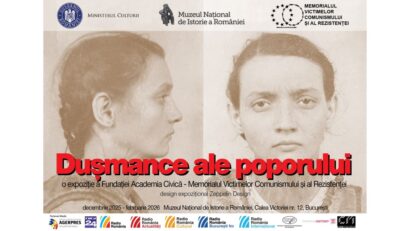The student Press in Communist Romania – The “Amfiteatru” Magazine
The history of one of the most controversial magazines in the communist era.

Steliu Lambru, 01.09.2014, 13:01
A propaganda instrument of the Communist regime, the press was its top priority. As a rule, the press was associated with censorship. The General Press and Print Department was charged with controlling and supervising any piece of information targeting the public at large and was subordinated to the Romanian Communist Party’s Central Committee. Despite strict control, there were exceptions from the party’s general policy, which were not able however to weaken the regime. The Communist regime’s obsession was so big, that one of the exceptions grabbed more attention than necessary, given the measures taken against it.
Constantin Dumitru was an editor-in-chief with the student’s magazine “Amfiteatru” published by the Union of the Romanian Communist Students’ Associations. He recalls how the Communists banned an issue of the magazine he coordinated because of certain poems written by poet Ana Blandiana, which were considered an attack against the regime.
”It was December 1984. When reading Ana Blandiana’s poems, I obviously had a certain reflex and I told myself, this cannot be published. But then I wondered, why shouldn’t it? So I okayed them for print. I took the magazine to the Romanian Communist Students’ Association, because it wasn’t us who gave the print approval. After the Press Directorate was dismantled, the approval was given by the central bodies that controlled the publications, namely the Central Committee of the Communist Youth Union and the Council of the Romanian Communist Students’ Association. We, the editors in chief and deputy editors in chief, would approve the publication of each article in part. However, further approval by a higher authority was required, because they didn’t trust us. Another comrade had to check everything. I was the deputy editor in chief, and a member of the Central Committee of the Communist Youth Union and a member of the Communist Youth Council, because, let’s be honest, one could not be editor in chief unless one was a member of the nomenklatura. Constanţa Buzea, poet Adrian Paunescu’s first wife, was the head of the poetry department. And all she did was to approve the publication. Grigore Arbore was in charge with the respective issue, but I made the decision.”
“Amfiteatru” had a monthly circulation of 7,000 copies, of which 3,000 were distributed in kiosks, 1,000 went to subscribers and another 3,000, paid for by the Union of the Communist Students’ Associations of Romania, were distributed to halls. Constantin Dumitru recalls how the scandal started:
”I went to the Nifon attic to visit a friend of mine, a fine artist, to brag about it. I just couldn’t help myself. So I took the galley proof with me, went to him and said ‘Look what I’ve done!’ I had no idea he was working for the Securitate. In a way I reported myself. That’s why they kicked me out. For having bragged I did it. What happened next was easy to predict. I was kicked out from all organisations I was part of. Meetings were held in my absence for this particular purpose. I found about them from the Free Europe radio station. Then, on January 15, 1985 I was fired. I was unemployed for about three months. Then I was hired by the Labour Protection magazine, against my will. My wife, pregnant at the time, was fired as well, to make her pay too for what I had done. After all, we had a contract and I violated it. But I did not complain then and I don’t complain now. I had a big salary, my own driver and secretary, all of these just to show respect to comrade Ceausescu and I still wasn’t showing him enough respect. It was at that time that I stopped looking up to politicians.”
As officially there could be no unemployment back in those days, Constantin Dumitru was given a job with a magazine specializing in industrial labour safety, but not in a management position. We asked him about the consequences of banning that issue of “Amfiteatru” magazine:
“Back in the day, photocopying was not for everyone, as it is now, you needed a lot of official passes for it. Copying machines of any kind were closely monitored. One of the greatest shocks I had was when a political police officer told me years later that those poems were copied five or six thousand times in Romania back then. In a manner of speaking, it made up an entire regular issue of the magazine, in fact it was double the issue of the magazine. And if so many Securitate officers were writing so many reports, there is no way Radio Free Europe wouldn’t catch on, and so those poems were broadcast on Radio Free Europe after I got dismissed. Not before that, though. The communists made a mistake, in a way. If they hadn’t made such a big deal out of it, it would have blown over. As that beautiful poem said, ‘I believe we are a vegetal people, who has ever seen a tree revolt?’ That poem was truly beautiful”.
After 1989, Constantin Dumitru had the opportunity of meeting the poetess that got him fired:
“As strange as that may sound, I didn’t know Ana Blandiana. I had published some of her pieces, but didn’t know her. No harm came to her, as opposed to me. The more so as she later published ‘Shallot the Tomcat’ at Ion Creanga Publishing House, which got more people fired. I was at the US Embassy in 1990, and writer Mircea Dinescu comes to me and said: ‘Hey, here’s your buddy, Ana Blandiana.’ He couldn’t believe I’d never met her. He went to Ana Blandiana and told her that I was the one that got her published in Amfiteatru. To which Ana Blandiana replied with a line that I truly admire: ‘That was his job!’ And I realized that she was right, that was my job. I did my job, and so did she, I suspect.”
Constantin Dumitru learned a lesson that should be valuable for others too. When you tell the truth, no matter how inconvenient, no price is too small to pay, because the satisfaction is even greater.






























